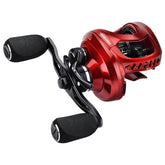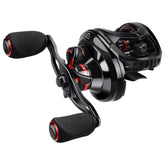
How to Spool a Spinning Reel
Have you picked up a spinning reel and wondered “How do I put line on this thing?” Don’t worry because plenty of anglers have done the same. It can be very confusing and intimidating at first but after doing it once, you will have the confidence and skill as a seasoned pro. To help you along this blog, we’ll go step by step on how to properly spool a spinning reel. Regardless of your experience level, after reading this blog you will have the knowledge and skill to properly spool your spinning reel with fresh line.
Getting the spool ready
Getting the reel ready to spool is very easy. I prefer to use a rod when spooling my reels. If I am indoors, I will use the bottom section of a two-piece rod. I use a rod because I can ensure that the line is going onto the reel straight without much slack. Run the line through the rod guides then run it through the actual line guide on the reel you are going to the spool. Ensure that the bail on the reel is in the open position and not closed. If the bail is closed you cannot properly spool the reel. When selecting a line to use remember that each line is going to have its own diameter. Twenty-pound test of mono-filament is going to fill your reel up a lot faster than 12-pound fluorocarbon since mono-filament is much thicker. Choosing your line should depend on what type of fish you are targeting.

Tying the line to the spool
The great thing about spooling a spinning reel is the accessibility of the spool itself. Unlike baitcasters and spincast reels, nothing has to be taken off to access the spool. The knot I have always used to tie it to the spool in an Arbor Knot. I have sat and listened to KastKing pro Brent Chapman and he recommended tying a Uni-Knot to the spool and that is also a great option. Both of those knots are simple and will secure your line to the spool. Tying a regular square knot will not hold as the line will slip. Tying a large knot will cause your line to not evenly spool. When using braid or fluorocarbon, ensure to wet the line when tying and tightening the line so the line does not burn into itself and that can potentially cause premature failure.
Avoid Line Twist
Line twist on a spinning reel is sometimes overlooked. Ensuring that a spinning reel is spooled correctly is simple by using the tools that KastKing offers. One is the Radius Line Spooler and the V10 Rod Rack that has a spooling station built-in. Line spooler tools allow the line to unroll from the filler spool and directly to the reel without any line twist. Line twist can create a number of problems. When the line is twisted, the strength and durability of the line can become compromised. If the line twist too much it will break under a lot of pressure. When reeling in a fish, every detail counts, and any weakness in the line will be exposed. I understand that some people may now be able to purchase a line spooler and there are many different ways to properly hold the line. I’ve seen pictures with a spool of line in a rice cooker and the line is ran through the vent hole. That is a very smart way of doing but there is no tension on the line. Remember that improper spooling can lead to a nightmare on your fishing trip. Proper tension is required to spool your reel correctly. If you are in a pinch and on the water, you can always run a pen or screwdriver through the line and secure it with either your toes or the hole on your Crocs. I know that sounds weird but that’s the way I did it as a child. You can apply pressure by simply using your feet.

Close the bail and start reeling in the line
Even with a line spooler and your line guide on the reel, you might notice that the line is spooling unevenly. The line may bunch at the bottom of the spool. Stop and make sure there is nothing stopping the spool from operating correctly and slow down on reeling the reel. This is to ensure that the line is spooling evenly and that you are getting the right amount of line on your spinning reel. Having the right amount of line on your reel is very important. Too little and you might run the risk of running out of line on a long cast or even worse! Running out of line on a big fish would be absolutely devastating! Maintain a firm grip on your reel and a constant steady retrieve. When reeling, do not reel too fast and only fill the reel up to about a 1/8th of an inch from the end. If you spool too much line on your reel it may interfere with the reel’s ability to function properly. It may hit the bail of the rail and cause more damage to your line.
Conclusion
Spooling up a reel with fresh line can be a daunting task but it is part of regular maintenance for every angler. Remember to be mindful of the line you choose. Next, secure the to the reel’s spool. Use an Arbor Knot or a uni-knot and it’s very easy to do on a spinning reel spool. If it does become difficult set it down and take a deep breath. Then, use a line spooler and make sure the line is running through the rod guides and the reel’s bail. If you do not have a Line Spooler than use some of the other creative ways to hold your line. Finally, keep the proper tension and do not under fill or over fill your reel. The most effective way I have found to do this is using a tool line the KastKing Radius Line Spooler. It comes with tools to secure your line like the KastKing Line Boss. Having the proper alignment and proper tension will make maintenance on your equipment a lot easier and ensure you get the most out of your line.












